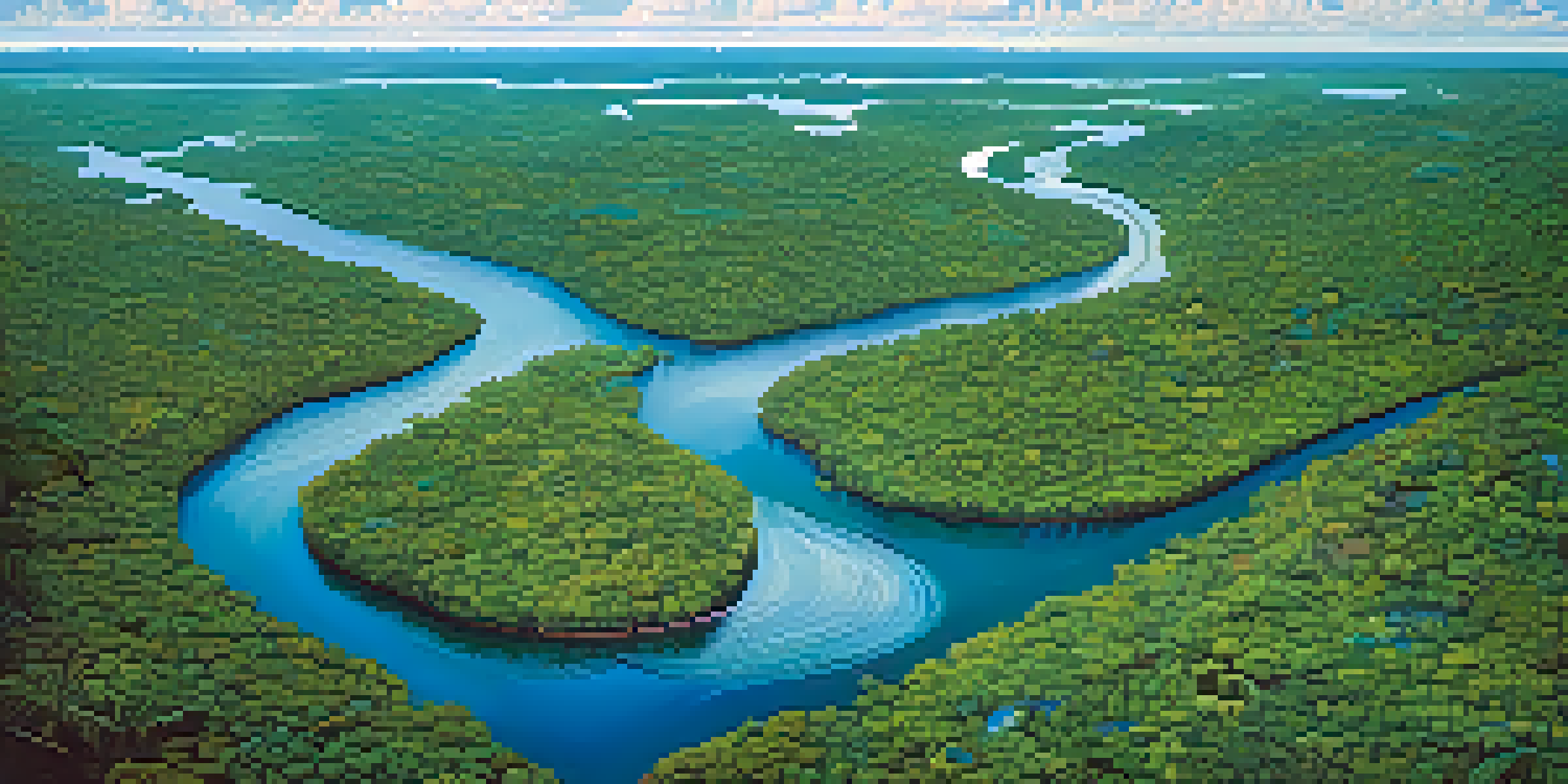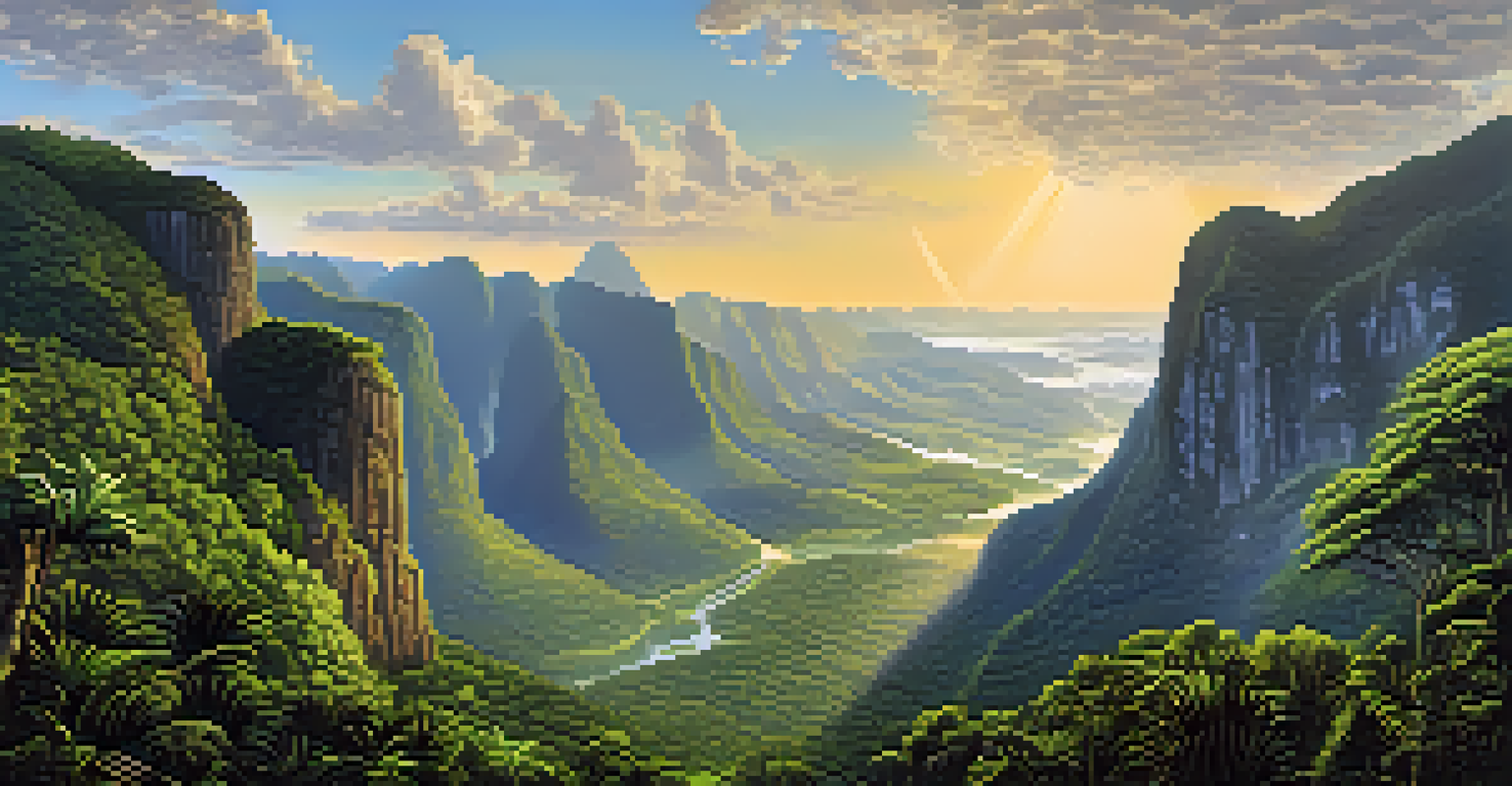A Journey Through Brazil's Unique Geological Landscapes

Introduction to Brazil's Geological Richness
Brazil is a land of incredible geological diversity, boasting landscapes that tell the story of millions of years of earth's history. From the Amazon rainforest to the Pantanal wetlands, the country showcases an array of features shaped by natural forces. This journey through Brazil's unique geological landscapes will reveal the hidden gems of this vibrant nation.
The Earth has music for those who listen.
Understanding Brazil's geology is not just about rocks and minerals; it’s about the ecosystems and communities that thrive within them. Each region has its own distinct geological characteristics, influenced by ancient tectonic movements and climatic changes. As we explore, we’ll uncover how these geological wonders have shaped both the environment and the culture.
From the soaring peaks of the Andes to the expansive lowlands of the Cerrado, Brazil's terrains offer a fascinating glimpse into the planet's geological processes. Join us as we traverse through these remarkable landscapes, each with its own story to tell.
The Amazon Basin: Nature's Geological Masterpiece
The Amazon Basin is not only the largest rainforest in the world, but it also showcases unique geological features shaped by the mighty Amazon River. The river has carved deep valleys and created an intricate network of waterways that support diverse ecosystems. This rich biodiversity thrives on the layers of sediment deposited over millennia, making it a vital area for both science and conservation.

As we navigate through the Amazon, it's easy to see how the geological landscape influences the flora and fauna. The floodplains, for instance, are teeming with life, while the surrounding hills provide a different habitat altogether. This striking contrast illustrates how geological formations can dictate ecological zones, leading to remarkable biodiversity.
Brazil's Geological Diversity
Brazil showcases a remarkable range of geological landscapes, from the Amazon Basin to the Brazilian Highlands, highlighting the country's rich ecological and historical significance.
Moreover, the Amazon's geology plays a crucial role in regulating the global climate. The interaction between the land and the atmosphere helps to absorb carbon dioxide, highlighting the importance of preserving these landscapes. As we appreciate the beauty of the Amazon, we also recognize our responsibility to protect this natural wonder.
The Pantanal: A Wetland Wonder
The Pantanal, the world's largest tropical wetland, is a geological phenomenon that supports a staggering variety of wildlife. This region's unique topography, characterized by seasonal flooding, creates a dynamic habitat that changes dramatically throughout the year. The interplay of water and land here is a prime example of how geology can shape ecosystems.
In every walk with nature one receives far more than he seeks.
During the rainy season, the Pantanal transforms into a vast, shimmering lake, attracting migratory birds and other wildlife. As the waters recede, the landscape reveals lush grasses and vibrant flowers, creating a feast for the eyes. This cyclical nature highlights the importance of geological processes in sustaining life within this diverse environment.
In addition to its ecological significance, the Pantanal is a vital resource for local communities. The floodplain's fertile soil supports agriculture and fishing, while the landscape attracts ecotourism. By understanding the geological context of the Pantanal, we can better appreciate the intricate balance between nature and human activity.
Chapada Diamantina: A Plateau of Surprises
Chapada Diamantina is a stunning plateau in the heart of Bahia, offering breathtaking views and a rich geological history. This region is characterized by dramatic cliffs, deep valleys, and unique rock formations that have been sculpted by erosion over time. The diverse geology here not only creates stunning landscapes but also supports a variety of ecosystems and endemic species.
Hiking trails through Chapada Diamantina reveal hidden waterfalls, caves, and expansive vistas that showcase the region's geological wonders. As you explore, you'll encounter unique formations like the iconic Morro do Pai Inácio, which stands as a testament to the power of natural forces. Each step on these trails is a journey through millions of years of geological history.
Importance of Ecosystems
The unique geological features of regions like the Pantanal and Serra do Mar not only create diverse habitats but also play a crucial role in regulating local and global climates.
Moreover, Chapada Diamantina holds cultural significance for local communities, who have long relied on its resources. The interplay between geology and culture adds another layer to the experience, enriching our understanding of this remarkable region. It's a reminder of how landscapes can shape not just nature, but also human stories.
The Coastal Regions: Where Land Meets Sea
Brazil's coastline is a geological tapestry woven with sandy beaches, rocky cliffs, and vibrant ecosystems. The interaction between land and sea creates unique geological formations, such as sea caves and dunes, which are constantly reshaped by waves and tides. This dynamic environment not only supports diverse marine life but also provides stunning vistas for visitors.
Beaches like Copacabana and Ipanema are famous worldwide, but the coastal regions hold more than just sun and sand. The geological features along the coast, including the iconic Sugarloaf Mountain, reveal the geological history of the area. These formations were shaped by volcanic activity and erosion, offering a glimpse into the earth’s past.
Ecologically, the coastal regions are vital habitats for numerous species, from sea turtles to migratory birds. Protecting these landscapes is crucial, as they face threats from development and climate change. By exploring Brazil's coastal regions, we gain a deeper appreciation for the delicate balance between nature and human activity.
The Serra do Mar: A Mountain Range of Wonders
The Serra do Mar is a majestic mountain range that stretches along the southeastern coast of Brazil, showcasing spectacular geological formations. These mountains are a result of tectonic movements and erosion, creating a dramatic backdrop for lush rainforests and cascading waterfalls. The range’s biodiversity is a testament to the complex interactions between geology and ecology.
Hiking through the Serra do Mar reveals a treasure trove of geological wonders, from ancient rock formations to unique ecosystems. The region is home to species found nowhere else on Earth, illustrating how geology can drive evolution and adaptation. Each hike becomes an adventure, offering insights into the delicate balance of nature.
Need for Conservation
Understanding Brazil's geological heritage emphasizes the urgent need for conservation efforts to protect these vital landscapes and the biodiversity they support.
Additionally, the Serra do Mar plays a vital role in Brazil's climate, acting as a barrier that influences rainfall patterns. This relationship between mountains and weather highlights the interconnectedness of geology and ecology. Exploring this range not only satisfies our wanderlust but also deepens our understanding of the natural world.
The Brazilian Highlands: A Unique Ecosystem
The Brazilian Highlands, also known as the Cerrado, is a unique geological region characterized by rolling plateaus and diverse ecosystems. This area is marked by its distinctive savanna landscape, which supports a variety of flora and fauna adapted to the region's climate. The geology here is shaped by ancient rocks and mineral-rich soils, creating a rich tapestry of life.
The Cerrado is essential for biodiversity, hosting countless species of plants and animals, many of which are endemic. The geological features of the highlands, including rocky outcrops and river valleys, create diverse habitats that nurture this rich biodiversity. Exploring the highlands offers a chance to discover some of Brazil's most unique wildlife.

Moreover, the Brazilian Highlands are crucial for water resources, as they serve as a watershed for several major rivers. Protecting this region is vital for maintaining Brazil's ecological balance and ensuring the sustainability of its water supply. A journey through the Highlands is not just a trip through stunning landscapes, but also a look into the importance of preserving our natural resources.
Conclusion: Embracing Brazil's Geological Heritage
Brazil's geological landscapes are not just beautiful; they are essential to the country's identity and ecological health. Each region, from the Amazon to the Highlands, offers a unique perspective on the earth's history and the interconnectedness of life. As we conclude this journey, we recognize the importance of understanding and preserving these geological wonders.
By appreciating Brazil's diverse geology, we gain insights into the natural processes that shape our world. This knowledge fosters a deeper respect for the environment and highlights the need for conservation efforts. Every landscape has a story to tell, and it's our responsibility to hear those stories and protect them for future generations.
In embracing Brazil's geological heritage, we celebrate not only the beauty of its landscapes but also the rich tapestry of life they support. As adventurers and stewards of the earth, let us continue to explore, learn, and advocate for the preservation of these incredible natural wonders.